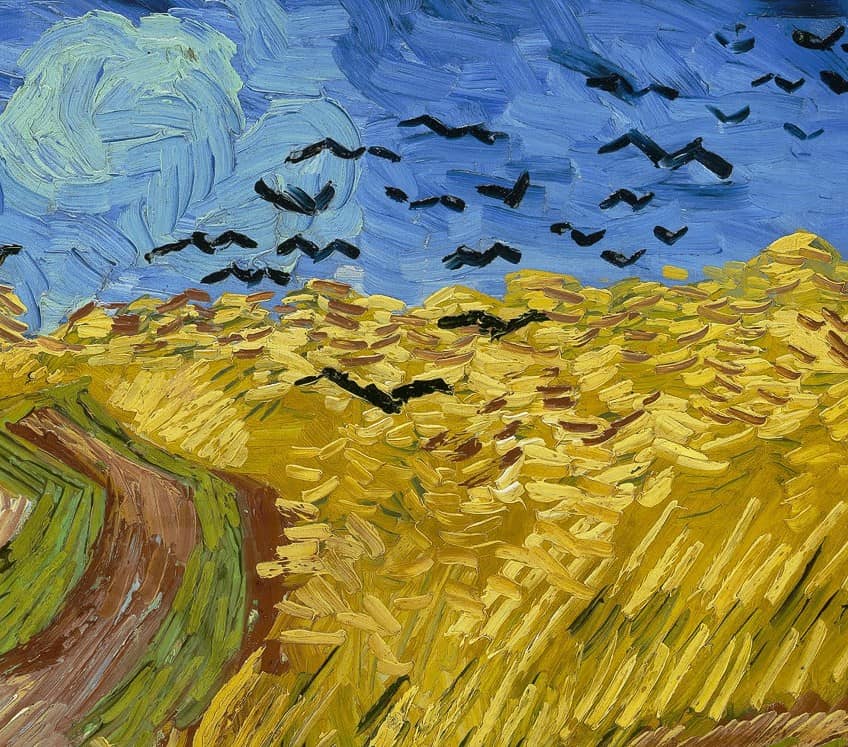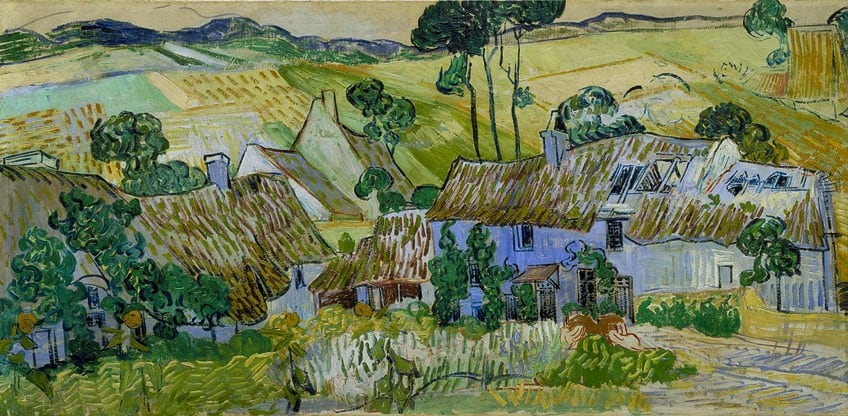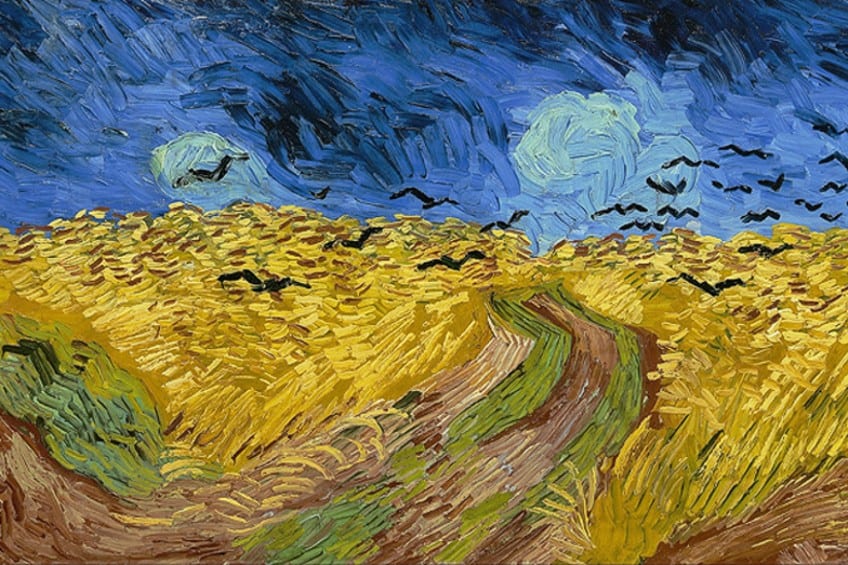“Wheatfield with Crows” by Vincent van Gogh – The Last Artwork
Wheatfield with Crows by Vincent van Gogh has long been regarded as the artist’s last artwork. Yet, after the production of the Wheatfield painting, he still produced several other works, with the last believed to be Tree Roots (1890). The myth that this was his last painting originated from the biopic Lust for Life (1956), in which Van Gogh was depicted producing the painting before shooting himself. Below, we will provide a Wheatfield with Crows analysis and learn more about its history.
How to Understand Wheatfield with Crows by Vincent van Gogh
| Artist Name | Vincent van Gogh (1853 – 1890) |
| Date Completed | 1890 |
| Medium | Oil on canvas |
| Dimensions (cm) | 50 x 103 |
| Location | Van Gogh Museum, Amsterdam, Netherlands |
On a plateau situated above Auvers-sur-Oise were wheatfields that Van Gogh loved to visit when he stayed for the last few months of his life. These wheatfields were only a few minute’s walk from where he was lodging and he would go there often to paint or just walk around. Before we go any further into our Wheatfield with Crows analysis, let us first find out more about the artist himself.
Introducing Vincent van Gogh
| Artist Full Name | Vincent Willem van Gogh |
| Nationality | Dutch |
| Date of Birth | 30 March 1853 |
| Date of Death | 29 July 1890 |
| Place of Birth | Zundert, Netherlands |
After spending many years working in various jobs, such as teaching, and art dealing, and even serving as a lay preacher. Van Gogh decided to devote all of his time to painting at the age of 27. He died only 10 years later, yet within that decade, he produced around 900 works of art! Yet, despite this incredible output, he did not experience any popularity in his own lifetime.
The epitome of the “struggling artist”, he spent those years living in poverty and surviving on a diet of bread, alcohol, and cigarettes. During this time, he was most financially supported by his brother, Theo.

The artist was also known to have suffered from undiagnosed mental illnesses as well as bouts of depression. In fact, one of his most renowned works, The Starry Night, was produced while he was staying in a mental asylum. His last few months were spent in Auvers-sur-Oise, where he produced several paintings before taking his own life by shooting himself with a revolver. One of those paintings was the Wheatfield painting. Unfortunately, it would only be after his death that his work began to experience the fame it does today.
Despite his obscurity during his own lifetime, he has since grown to be regarded among the most important painters of the modern era.
Wheatfield with Crows Analysis
Produced on a double-square canvas, this Wheatfield painting portrays a cloud-filled sky over a field filled with crows. The haphazard flight pattern of the crows and the path that seems to lead nowhere add to the feeling of isolation produced by this artwork. The majority of the artwork is taken up by the wind-swept fields of wheat. Their golden hues contrast perfectly with the dark skies above.
It is believed that the crows in the artwork represent death as well as resurrection or rebirth. It was also believed that they were very observant and that nothing escaped the attention of crows.
They also often symbolize bad luck or death, yet it is not known for sure in which way the artist intended them to be seen. The artwork overall seems to convey a sense of sorrow that accompanies the ending of life, perhaps mirroring how the artist felt at the time of its production. It is further believed that the green and red road was added metaphorically to represent the long road spoken about in The Pilgrim’s Rest, from which the artist had once given a sermon.

Van Gogh believed that wheat was very symbolic. The seeds would be sown in autumn, and towards the end of the wintertime the seeds would begin to sprout, by spring the fields would be green, and by late July the golden crop would be ripe and ready for harvesting. While the harvest signified a time of abundance, there were periods when the fields were barren. Year after year, this process would continue, which for the artist, represented the cycles of life. Wheat is a Christian symbol of divine love, and it also symbolizes the fruits of honest labor to the artist.
We know that the Wheatfield painting is one of the last artworks that he produced before committing suicide, due to the letters he wrote to his brother on the 10th of July 1890.
In these letters, he stated that he had produced three more paintings since the 6th of July when he was visiting them in Paris. Two of these were said to be wheatfield paintings with cloudy skies, and the other was called Daubigny’s Garden. He further stated that he wanted the works to convey a sense of isolation at the same time as illustrating what he regarded to be the healthy aspects of country living. Therefore, while the crows give the artwork an almost sinister and foreboding feeling, the swaying wheat imbues the work with vitality.

The Wheatfield painting is often regarded among the artist’s most contentious works. No other of his works has been subject to as much variation in interpretation. Some see it as a positive representation of country life, whereas others view it as a visual suicide note. These were, after all, the very same wheatfields in which he would subsequently take his own life.
Van Gogh’s brother passed away six months later and both were buried in a cemetery that overlooked these wheatfields that he so loved to depict.
Was the Wheatfield Painting His Last Work?
While his letters to his brother may have been written in the last few weeks before he took his own life, the artworks he wrote about were not his last works. Van Gogh famously produced hundreds of works in a decade and always finished any piece he started. It has therefore been argued that Tree Roots is actually his last work as it was written during this period and was left incomplete. So then why has there been a persistent idea that this wheatfield painting was his last?
While it was thought to be his last since the start of the previous century, the idea cemented itself in the public imagination after the release of the movie Lust for Life (1956). In this famous biopic, the actor who plays Van Gogh dramatically paints the crows in the artwork before walking off-screen and shooting himself.

Farms near Auvers is another of Van Gogh’s works that was thought by some to be his final piece. It was even labeled as his “final sketch” when it was exhibited at the Salon in 1891. Yet, a couple of years later, the same person who exhibited the work described the artist’s final work as portraying a sunny underwood, which perfectly matches Tree Roots in its subject matter. In 1991, Wheatfield with Crows by Vincent van Gogh was stolen along with several other works but was quickly retrieved. Unfortunately, it had been quite badly damaged during the heist.
It is not hard to see why so many people would like to think of this as Van Gogh’s final piece. Seeing that he committed suicide only a few weeks later in these exact fields, it would seem a rather fitting narrative if it were his last work. The addition of the dark crows only adds to this perception, given that they are often regarded as a symbol of impending doom. However, to the artist himself, it symbolized isolation more than death, and it even symbolized the cycles of life, as the production of what was an annual activity that brought life once harvested. Van Gogh even stated that the work represented the healthy aspects of living the country life.
Frequently Asked Questions
What Was Van Gogh’s Last Painting?
In the weeks before Van Gogh took his own life, he produced several paintings that are often regarded to be his last. One of those was Wheatfield with Crows. However, it is believed that he had already completed this specific artwork on the 10th of July and produced a few more before he shot himself on the 29th of July. Therefore, the most likely contender for his last artwork is Tree Roots (1890). This work was incomplete at the time of the artist’s death, whereas the others were finished.
What Is the Meaning of Wheatfield with Crows by Vincent van Gogh?
This painting depicts a wheatfield underneath dark and cloudy skies. A group of crows can be seen above the field, hovering around in no particular direction. For the artist, this wheatfield painting was meant to convey both the beauty of country life and its sense of isolation. This painting is also discussed often because it was thought to be his last painting for a long time. In fact, the fields that are portrayed are the same ones in which he eventually took his own life.
Jordan Anthony is a Cape Town-based film photographer, curator, and arts writer. She holds a Bachelor of Art in Fine Arts from the University of the Witwatersrand, Johannesburg, where she explored themes like healing, identity, dreams, and intuitive creation in her Contemporary art practice. Jordan has collaborated with various local art institutions, including the KZNSA Gallery in Durban, the Turbine Art Fair, and the Wits Art Museum. Her photography focuses on abstract color manipulations, portraiture, candid shots, and urban landscapes. She’s intrigued by philosophy, memory, and esotericism, drawing inspiration from Surrealism, Fluxus, and ancient civilizations, as well as childhood influences and found objects. Jordan is working for artfilemagazine since 2022 and writes blog posts about art history and photography.
Learn more about Jordan Anthony and about us.
Cite this Article
Jordan, Anthony, ““Wheatfield with Crows” by Vincent van Gogh – The Last Artwork.” artfilemagazine – Your Online Art Source. November 2, 2023. URL: https://artfilemagazine.com/wheatfield-with-crows-by-vincent-van-gogh/
Anthony, J. (2023, 2 November). “Wheatfield with Crows” by Vincent van Gogh – The Last Artwork. artfilemagazine – Your Online Art Source. https://artfilemagazine.com/wheatfield-with-crows-by-vincent-van-gogh/
Anthony, Jordan. ““Wheatfield with Crows” by Vincent van Gogh – The Last Artwork.” artfilemagazine – Your Online Art Source, November 2, 2023. https://artfilemagazine.com/wheatfield-with-crows-by-vincent-van-gogh/.



